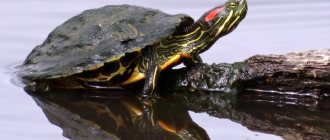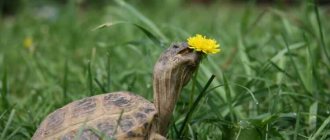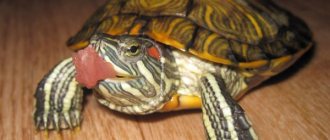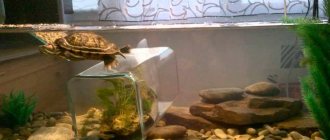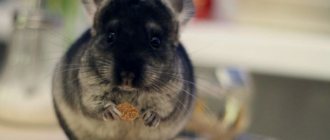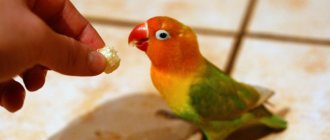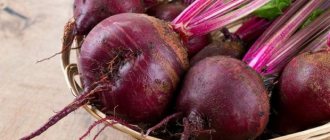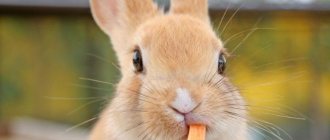When purchasing a turtle as a pet, it is reasonable to wonder what you can feed the turtles. Frivolous owners often begin to experiment with food, offering the new tenant either meat, cabbage, or milk.
However, this approach can end disastrously for the animal, which may get sick or die. Therefore, when giving a “living gift” to yourself or your children, it would be a good idea to first learn how to structure a turtle’s diet so that it will delight everyone with its presence in the house for a long time.
What do turtles like?
Most turtle species are herbivores. Therefore, about 80% of the daily diet should be all kinds of greens, and the remaining 20% should be other foods, which include vegetables, fruits, sometimes fish, vitamin and mineral supplements.
It is advisable to plan this 20% in advance a week or month in advance so that the turtle’s nutrition is balanced.
You should not overfeed the animal, but starvation will not do any good. Therefore, it is very important to know how to feed your turtle properly.
Vitamin and mineral complexes
Turtles need calcium to form their shell. fill the need for microelements with the help of bone meal - it is mixed into the food.
A pinch is enough for young redears; for older ones, a teaspoon is “stretched” for a week.
In addition, special vitamins for turtles are added in accordance with the instructions, but the shelf life of such food is limited.
Supplement to main food
You can add the following products to your turtle's daily food:
- sunflower seeds;
- Champignon;
- dry yeast;
- a piece of fresh fish.
Veterinarians recommend ready-made dry mixtures as a supplement, as well as vitamin and mineral supplements, which can be found in specialized stores. In the photo of turtle food on the Internet you can see what the finished food looks like and choose the appropriate option.
Once a week it is worth offering the turtle a boiled hard-boiled egg, and once a month - a garden snail, slug or large insect.
If the owners have acquired young animals, then the question naturally arises of how and how much to feed the small turtles. The diet of children is no different from the diet of adults.
The only point is that it is worth offering feeding to young animals not once a day, like adults, but twice.
Note!
Domestic turtles - the most popular species, cultivation features, tips for care and maintenance (115 photos + video)- Indian snakes: sacred, poisonous, most common and dangerous types of Indian snakes and their names (130 photos)
- Small snakes - an overview of popular and rare species, habitats, food and names of snakes (115 photos)
Artificial feed
Pet stores provide pet owners with a huge selection of food for land and aquatic turtles. It is sold in capsules, granules, tablets and flakes. The large amount of food produced by manufacturers does not always meet the needs of a particular species. Often, turtle food is modified fish food. Some animals are irritated by the pungent smell, and they demonstratively turn away from it. There are foods in which the content of calcium, protein and vitamins does not meet the needs of turtles. But some animals are happy to eat only food. Of the manufacturing companies, JBL, Sera, Nutra Fin, Tetra have proven themselves well.
Homemade food for red-eared turtles
If store-bought artificial food is not suitable, you can prepare your own treats for turtles.
Feed composition:
- cabbage – 50 gr.;
- carrots – 70 gr.;
- non-fatty fish – 145 g;
- apples – 50 gr.;
- squid meat – 100 gr.
Cooking method. All ingredients should be passed through a meat grinder, add 2 eggs, gelatin diluted in hot water (per 150 ml - 30 g) and milk in a volume of 150 g. Mix thoroughly, let cool and add 20 drops of Tetravita. The shelf life of the food in the refrigerator is 1 week. Before feeding, the mixture is cut into pieces and given to the turtle.
The prepared food is enough for 10 feedings, per 1 turtle with a shell length of 15 cm. If the animal is sick, you can add medicine to the food. Gelatin can be replaced with agar-agar. This will prevent the cubes from quickly melting in the water.
Feeding turtles food for cats and dogs. "Pros and cons"
Red Ears really like combined foods, but they are intended for feeding warm-blooded animals and are not suitable for turtles. The food contains a completely different set of substances that are useful for cats and dogs, but completely useless for turtles.
Prohibited Products
Despite the reptile's apparent readiness to eat everything that is offered to it, there is a list of foods that should absolutely not be given to turtles.
These include:
- all types of buttercup, nightshade and medicinal alkaloid-containing herbs;
- citrus fruit peel;
- all types of prepared food intended for other domestic animals;
- poultry and livestock meat, even boiled;
- any home-cooked dishes, including all dairy products, bread, cereals.
What not to feed
Aquatic turtles are omnivores. They can eat almost any food offered to them. But you shouldn't do this. They cannot digest all the food, which will disrupt the functioning of the gastrointestinal tract and lead to illness.
What not to give to turtles:
- food from the table;
- fruits and berries with seeds;
- sea fish;
- river fish of fatty varieties;
- onions, radishes, eggplants (they are spicy for animals);
- citrus peel;
- pork, lamb (too fatty, it is difficult for turtles to digest such meat);
- amber snail meat;
- elodea (contains poisonous juice).
Video on the topic. What can you feed a red-eared turtle?
Features of feeding turtles
Turtles are diurnal animals, so they are offered food in the first half of the day, when the animal is most active. It's best to have it at the same time.
The winter diet will definitely differ from the summer one, but don’t let this scare the owners. After all, turtles in nature change their habits with the arrival of winter, and many are not averse to hibernating.
In any case, the activity of pets in winter decreases somewhat. This also affects the reptile's appetite. She eats less, preferring dry food.
Attentive owners always notice changes in their pets’ food preferences in time and try to please them.
However, an alarming moment can be a long and causeless refusal of the animal to eat. In this case, it would not hurt to consult a specialist to prevent the death of your pet. In general, with proper nutrition, turtles grow well, move actively and delight household members with their exotic appearance.
Drinking regime
Red-eared turtles from the family of freshwater turtles live in the wild in small lakes with well-warmed water by the sun or ponds with swampy shores. For these reptiles, fresh water is vital (they cannot live without it for even a couple of days). The redfish spends its entire life in water - activity and sleep, eating and the process of defecation.
The red-eared turtle spends its entire life in water - activity, sleep, eating
The question of whether a turtle has a need to drink has not been fully studied. The structural features of her body do not allow water to linger: in the process of drinking, it pours out of her nostrils and flows down her neck. Moisture, so necessary for reptiles, penetrates through its skin, as well as from the products it eats.
Photo of turtles feeding
Taking care of your health
Compliance with all the rules for the care and maintenance of waterfowl turtles in a home apartment will protect the animal from possible infections and diseases. However, any pet can get sick. Common diseases and treatments are presented in the following table:
| Disease | Symptoms | Treatment |
| Abscess / Otitis | Tumor in the ears, on the limbs | Operation |
| Pneumonia | Does not drown, falls over, does not eat, wheezes, white mucus and bubbles appear from the nose | Deadly. Treated in a hospital or at home with injections |
| Conjunctivitis/swelling/redness of the eyes | Swollen eyes, redness, suppuration under the eyelids, lack of appetite | Local treatment |
| Soft/Twisted Shell (rickets / osteopenia / hypocalcification) | Softening of the shell, its curvature | The curvature process is irreversible; local treatment |
| Helminthiasis | Diarrhea/constipation, presence of helminths in tests | Treatment by a veterinarian |
| Dermatitis/skin fungus | Increased shedding, skin redness, white growths | Treatment by a veterinarian |
